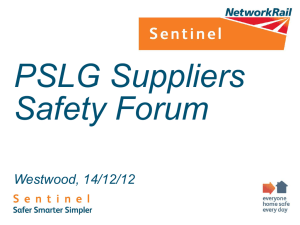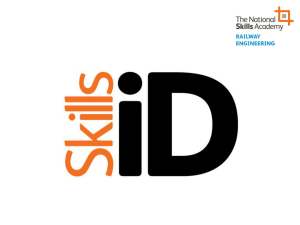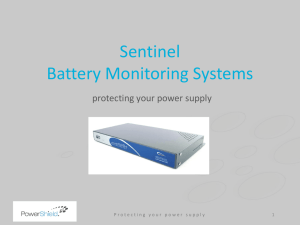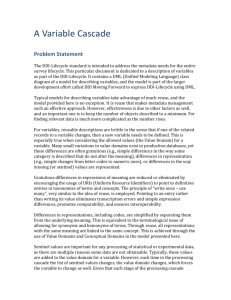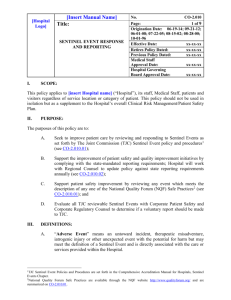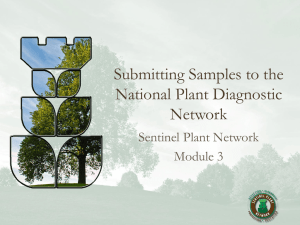TIFFE/CAMHD Documentation Training
advertisement
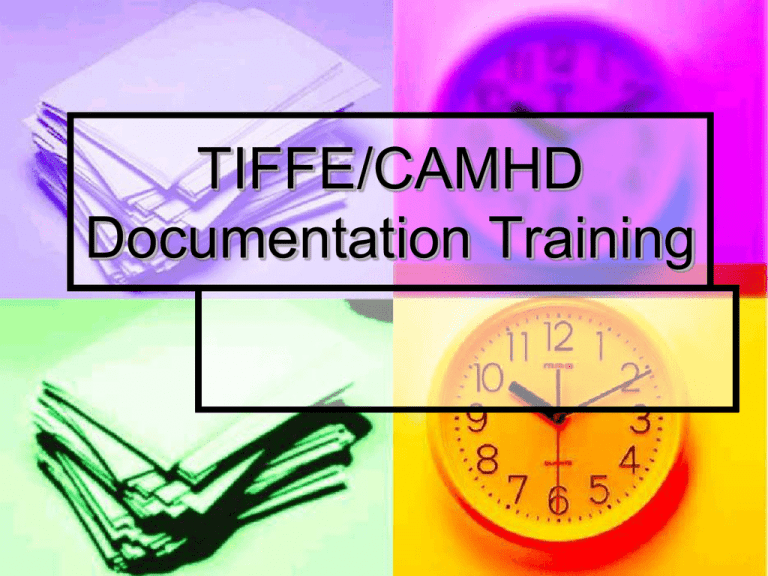
TIFFE/CAMHD Documentation Training GOALS To ensure clinicians are adherent to CAMHD/TIFFE documentation requirements (i.e., format, timeline, structure, etc). To ensure clinicians produce/provide quality of documentation (i.e., individualized to each client/family, S.M.A.R.T.). AGENDA Pre-test Required Intake Forms. Mental Health Treatment Plan (MHTP). Progress Notes Monthly Treatment and Progress Summary. Sentinel Events Report. Annual Summary Reports. Behavioral Plan. Discharge Summary. INTAKE FORMS Handout and Sample. THE PURPOSES of MHTP Contract agreement between client and provider. Guide the course of treatment for identified problems or issues. Evaluate the client’s progress in meeting specified goals and objectives. Mean of communication between providers. STEPS IN DEVELOPING MHTP Gather information Review available information (reports, CSP, medical records, court records, school records, etc.). Interview process (youth, caregivers/guardians, other provider/treatment team members, etc.). Develop case formulation Identify clients’ current situations and what they want to accomplish. Determine the most effective and appropriate ways to help clients achieve their goals. Identify possible barriers in accomplishing the goals. Determine an estimated time to accomplish the goals. REQUIRED COMPONENTS OF MHTP Client’s DSM-TR IV diagnosis code(s) consistent with the assessment(s). Goals and measurable objectives. Target dates. Appropriate strategies/interventions (Best Practices). A list of the services to be provided/who will provide the services. Crisis plan. Transition/Discharge Plan. REQUIRED COMPONENTS OF MHTP Signature of client (when appropriate). Signature of the client’s parents, guardian, or legal custodian. Signature of the treatment team members who participated in the development of the plan (at minimum MHCC). Date of start and end of services. MHTP Goal (WHAT)) The end point of therapeutic work (Desired outcome). Example of Goals: Family = Develop positive family interaction. School = Improve school/academic performance. Community = Increase involvement in community activity. Individual = Improve problem solving skills. Social/Peer = Develop and maintain positive peer interactions. Legal = Maintain no involvement in law violation. MHTP Objective (HOW) Step(s) in achieving the goal. S pecific M easurable A ttainable R ealistic T ime-limited MTPS (Objective Examples) Domain Goals Measurable Objectives Individual Develop ability to communicate and verbalize feelings. Joey will be able to identify and label his feelings 90% of the time for a period of 3 months. Joey will be able to verbalize his feelings to trusted adults/peers 75% of the time for a period of 3 months. Joey will use an “I” statement message to communicate his feelings to trusted adults/peers 75% of the time for a period of 3 months. MHTP (STRATEGIES/INTERVENTIONS Based on best practice. Need to consider youth’s diagnosis/issues. Need to consider youth/family’s cultural in identifying appropriate interventions. Need to consider youth/family’s resources or lack of resources. Need to consider youth/family readiness for change. REQUIRED COMPONENTS OF MHTP Crisis Planning: Address settings events, triggers, preventive as well as reactive intervention. Must focus on early intervention. Transition/Discharge Plan: Begin at the initial meeting. Describe the supports and necessary services for successful and smooth transition. Identify the criteria for transition or discharged based on MHTP goals and objectives. Need to include contigency plan. MHTP needs to be completed within 10 days of intake. CHARACTERISTICS of GOOD MHTP Individualized to each client/family. Directly linked to achieving goals in a client’s IEP or/and CSP. Identify client/family’s challenges as well as strengths areas. Based on strengths, and needs driven. Must be developed with youth (when appropriate) and parent/guardian involvement. Written in client/family language. Problems/issues are stated using positive language. Goals/objectives/interventions are appropriate to the client’s diagnosis, age, culture, strengths, abilities, preferences, and needs expressed by the client/family. Goals/objectives/interventions need to be attainable, realistic, measureable. MHTP GROUP ACTIVITY “Creating A Treatment Plan” PROGRESS NOTES Purpose Serve as documentation of treatment. Track therapy progress. Essential part of therapy process. Ensure quality assurance. Format (DAP) D escription: A ssessment: This section is where you assess, in descriptive terms, the client’s performance during the session and/or the session itself. P lan: The final section of your DAP notes is where you outline the course of treatment, after considering the information you gathered during the session. Next session date. PROGRESS NOTES Things to consider when writing progress notes: Who are you writing your progress notes for? Yourself (clinician) TIFFE (supervisor/program manager/clinical director) CAMHD (care coordinator, auditor, QA people) Who will have access to your progress notes? PROGRESS NOTES Who will have access to your progress notes? Agency (Supervisor, Clinical Director, etc.). Client/Caregiver CAMHD (care coordinator, chief branch, CAMHD psychologist, etc) Court system (probation officer, judge, etc.) Other agency/provider involves in client’s therapy (i.e., teacher, CPS, individual therapist, psychistrist, etc). Progress Notes How much information need to be included? Need to include adequate information in regard what occur in therapy session related to therapy goals/process. What are the issues being address? What are the goals being work on.? How do the issues or goals are being address (specific strategies/intervention)? How does youth response to intervention? What progress does youth make (describe the progress)? Is there any issues that might hinder the youth’s progress? How does this issue is being address? PROGRESS NOTES What types of information need be included? Only include information, issues, or problems that have direct impact on youth’s level functioning or directly related to treatment. PROGRESS NOTES Who Relies On Your Documentation: Treatment Team members Referral Sources To advocate for the most appropriate and effective care for client. Employers Other Payors To justify need for continued treatment, need for admission, demonstrate appropriateness and cost-effectiveness of care, demonstrate all billable services were provided. PROGRESS NOTES Samples of good progress notes. Handouts. Practice writing progress notes. MONTHLY TREATMENT AND PROGRESS SUMMARY SENTINEL EVENTS REPORTS Purpose To establish uniform guidelines for a reporting system that is designed to track and document sentinel events and the follow-up of the events reported by the CAMHD Branches and contracted provider agencies (provider). Definitions Sentinel Event: An occurrence involving serious physical or psychological harm to anyone or the risk thereof, as defined under the categories of sentinel event codes and definitions. Critical Event: Events involving serious injury or death, suicidal attempts, sexual misconduct, allegations of staff abuse or misconduct. SENTINEL EVENTS REPORTS Procedure When a sentinel event occurs the provider: Notify the youth’s legal guardian, and MHCC within 24 hrs of the occurrence of the sentinel event, either by phone of fax. Complete CAMHD’s sentinel event report form (signed by TIFFE’s clinical director or supervisor on site). Sentinel event report (signed by clinical director/supervisor on site) need to be faxed to SES and MHCC within 72 hours of the sentinel event. SUMMARY ANNUAL ASSESSMENT Purpose: Address significant changes, current status and consequent recommendation. Information to be included: Measures of youth’s behavior and functioning CAFAS/PECFAS and ASEBA checklist for parents, teacher and youth’s self report form need to be included. Structure/format (see handout). Write a progress notes indicating that you are working on Summary Annual Assessment (for billing purpose). DISCHARGED SUMMARY Written discharge summary must be submitted to appropriate CAMHD Branches within ONE week of service termination. Post CAFAS/PECFAS needs to be completed and turn in with your D/C summary. CAFAS/PECFAS needs to include pre/post score on individual as well as family functioning. D/C date is the last session you had with youth/family. SENTINEL EVENT REPORT Sentinel events Handouts. Sample. Closing Q&A Post-test Evaluation
